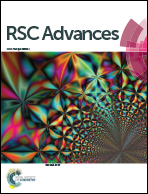Computational study on thermally activated delayed fluorescence of donor–linker–acceptor network molecules†
Abstract
Using Density Functional Theory (DFT) and time-dependent DFT calculations, we have investigated the structure–property relationships of organic molecules with donor–linker–acceptor (DLA) frameworks which can be used as precursors of OLED materials. Two types of linkers, thiophene (π-conjugated) and ethylene (non-π-conjugated), with carbazole as the electron donor and cyano-substituted benzene as the electron acceptor in the DLA framework were chosen. The donor–linker–acceptor network allows the HOMO and LUMO orbitals to be spatially separated, reducing the overlap of the frontier orbitals and decreasing the exchange energy (J); this results in a smaller ΔEST (energy gap between the excited singlet and triplet states), thus allowing us to realize metal-free molecules suitable for OLED applications. Incorporation of donor and acceptor groups in the same moiety helps reduce the number of layers conventionally used in OLEDs, reducing the cost and simplifying the fabrication of the device. By enhancing the electron donating nature of the donor group and increasing the electron withdrawing nature of the acceptor group, we observed a decrease in exchange energy, which was further decreased by the non-conjugated linker. Important properties such as the changes in dipole moments, absorption and emission energies and their corresponding oscillator strengths, transport energy gaps, electron affinities, ionization potentials (vertical and adiabatic), reorganization energies, and exciton binding energies of various substituted molecules were investigated and their roles in determining the efficiencies are discussed. In order to account for the effects of solvents and their role in altering various properties, the studies were carried out for polar and non-polar solvent phases in addition to the gas phase calculations.


 Please wait while we load your content...
Please wait while we load your content...